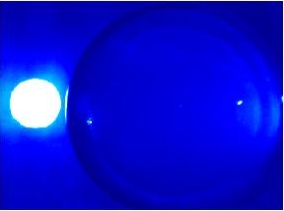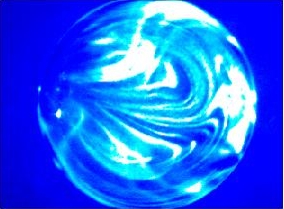

 |
 |
This research is supported by NSF under grants DMS-0400370 and CTS-0201610 (Disclaimer) and by the American Chemical Society Petroleum Research Fund under grant 42403-AC9. |
We are developing a novel approach to manipulating and controlling the dynamics of microscopic amounts of liquid based on using a spatially and temporally modulated illumination field to generate surface tension gradients driving the microflow. This approach allows us to explore many fundamental problems such as the well-known contact line instability in the spreading of thin liquid films and thermocapillary migration of and mixing in microdroplets. This approach also promises to revolutionize such practical applications as the industrial process of coating chemical and biochemical analysis/synthesis using miniature microfluidic devices known as "labs-on-a-chip".
In the case of thin films, the liquid spreads over a horizontal solid substrate illuminated with a light beam (click to see figure). Absorption of the beam in the substrate impresses a thermal pattern, where the local substrate temperature increases with illumination intensity. For sufficiently thin films, the thermal gradients in the substrate are directly transferred to the air-liquid interface, thereby, inducing surface-tension gradients (thermocapillary effect) that drive the flow. With this novel technique, flow perturbations with a well-defined structure can be imposed by suitable spatial and temporal modulation of the light intensity. In one series of experiments, the perturbations are used to excite a family of unstable modes as well-defined initial conditions; by monitoring the subsequent time-evolution of these flows, the dispersion relation for instability of moving contact lines can be measured and compared with theory based on lubrication approximation. In another series of experiments the perturbations are applied as feedback in response to measurements of the flow; in this way, suppression of contact line instability via feedback control is demonstrated.
Microdroplets driven on a liquid substrate by temperature gradients can be thought of as a prototype of a microscopic chemical lab. By combining basic fluidic operations such as moving, merging, metering (splitting), and mixing and thermal cycling one can build a "lab-on-a-chip" which, unlike currently existing single-use devices, can be dynamically reconfigured to perform different analyses. Our research deals primarily with the physics of the microflow. The focus of current investigation is on mixing in microdroplets. Contrary to naive expectation, good mixing becomes progressively more difficult to achieve as the spatial scale decreases -- turbulent flow at the macroscale, which usually governs mixing rates, is replaced with a laminar one at the microscale. Furthermore, surface forces which dominate at the microscale make droplets nearly spherical and as a consequence the flow inside them becomes highly summetric. The symmetry leads to the existence of flow invariants serving as barriers to transport inside the microdroplet and hence inhibiting mixing. The key to achieving good mixing is designing a chaotic flow breaking all of the symmetry-imposed invariants. The pictures below show a dyed droplet being injected into a larger, undyed droplet (left) and the mixing of the dye via the process of chaotic advection characterized by repeated stretching and folding of the dyed volume (right). You can also watch the movies of the droplet driven along a line and around a square path.
 |
 |
Go back to Home Page